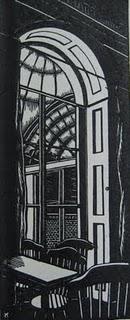 Frank Kermode, At 33, Warwick SquareWoodcut, 1930
Frank Kermode, At 33, Warwick SquareWoodcut, 1930Born in 1881, Walter Claude Flight was the most influential figure in the development of the colour linocut as a key element of the Modernist aesthetic. Influenced by the Futurists, Flight embraced the linocut as a truly democratic art form, and one that was capable of expressing the power, energy, and expressive movement of the Machine Age. Flight was a cousin of the writer Rudyard Kipling. He had tried various careers - including engineering and beekeeping - before he entered Heatherley's School of Fine Art in 1913. Although his time at Heatherley's was cut short by the outbreak of WWI, the relationships he forged there were crucial to the development of Flight's art. One notable fellow-student was C. R. W. Nevinson, who introducted Flight to the work of the Futurists. Flight married a fellow-student, Clare James, in 1915. This marriage produced two daughters, but did not last. From 1922 until his death, his companion was a fellow linocut artist, and textile designer, Edith Lawrence (1890-1973). Flight and Lawrence shared an exhbiition of textiles and linocuts at the Redfern Gallery in 1928. All of my linocuts by Claude Flight come from the book Christmas and other Feasts and Festivals: A Picture Commentary for Grown-Ups, published by George Routledge in 1936. The book is credited to Claude Flight (who is the author of the brief introduction), but the 45 two-colour linocuts that follow are "Printed from Linoleum Blocks cut by Claude Flight and Edith Lawrence". The printer was Headley Brothers; the cuts are printed on both sides of the paper, back-to-back.
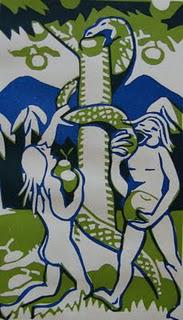 Claude Flight & Edith Lawrence, The First FeastLinocut, 1936
Claude Flight & Edith Lawrence, The First FeastLinocut, 1936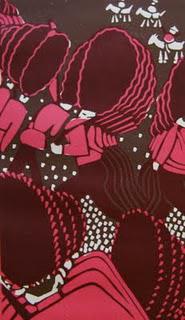 Claude Flight & Edith Lawrence, Trooping the ColourLinocut, 1936
Claude Flight & Edith Lawrence, Trooping the ColourLinocut, 1936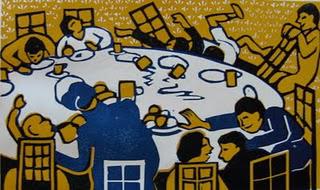 Claude Flight & Edith Lawrence, Nursery TeaLinocut, 1936
Claude Flight & Edith Lawrence, Nursery TeaLinocut, 1936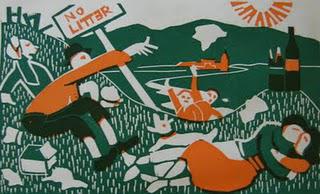 Claude Flight & Edith Lawrence, English PicnicLinocut, 1936
Claude Flight & Edith Lawrence, English PicnicLinocut, 1936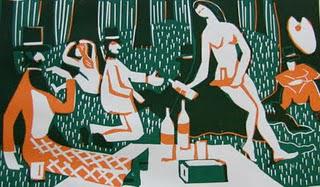 Claude Flight & Edith Lawrence, French PicnicLinocut, 1936
Claude Flight & Edith Lawrence, French PicnicLinocut, 1936There is no way of knowing which hand cut which line, and the linocuts must be credited as joint productions of Flight and Lawrence; this method of joint creation was also employed by two other notable linocut artists of the Grosvenor School, Sybil Andrews and Cyril Power, working as Andrew-Power. I love the sly, quirky humour of these vibrant linocuts, which show both Claude Flight's sureness of line, and the ready wit with which Edith Lawrence was able to respond in a moment to the challenge, "Say something, Edith."
 Claude Flight & Edith Lawrence, Knocken ModdensLinocut, 1936
Claude Flight & Edith Lawrence, Knocken ModdensLinocut, 1936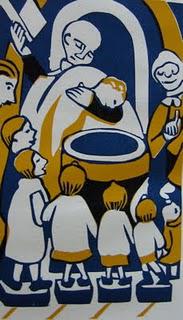 Claude Flight & Edith Lawrence, The ChristeningLinocut, 1936
Claude Flight & Edith Lawrence, The ChristeningLinocut, 1936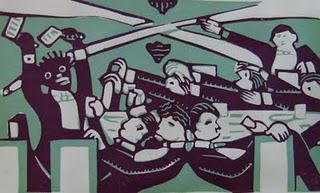 Claude Flight & Edith Lawrence, Bump SupperLinocut, 1936
Claude Flight & Edith Lawrence, Bump SupperLinocut, 1936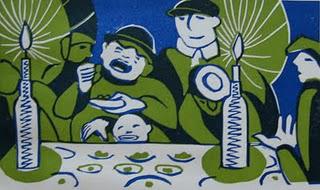 Claude Flight & Edith Lawrence, Winkle BarrowLinocut, 1936
Claude Flight & Edith Lawrence, Winkle BarrowLinocut, 1936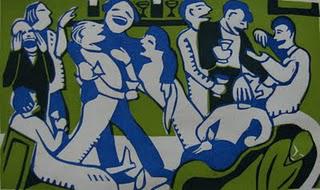 Claude Flight & Edith Lawrence, Cocktail PartyLinocut, 1936
Claude Flight & Edith Lawrence, Cocktail PartyLinocut, 1936Claude Flight is now seen as a pioneering Modernist, and it is ironic to note that he was expelled from the Seven and Five Society because of Ben Nicholson's rigorous doctrinaire insistence on abstraction as the only way forward for art.
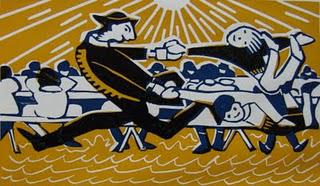 Claude Flight & Edith Lawrence, A School TreatLinocut, 1936
Claude Flight & Edith Lawrence, A School TreatLinocut, 1936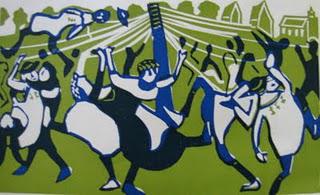 Claude Flight & Edith Lawrence, Maypole DanceLinocut, 1936
Claude Flight & Edith Lawrence, Maypole DanceLinocut, 1936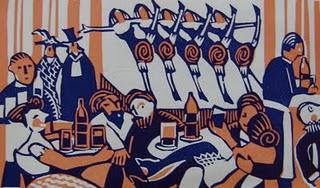 Claude Flight & Edith Lawrence, Café ChantantLinocut, 1936
Claude Flight & Edith Lawrence, Café ChantantLinocut, 1936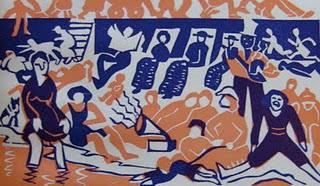 Claude Flight & Edith Lawrence, Summer HolidaysLinocut, 1936
Claude Flight & Edith Lawrence, Summer HolidaysLinocut, 1936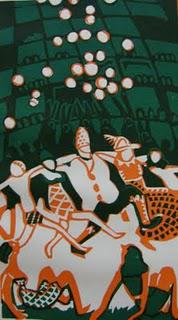 Claude Flight & Edith Lawrence, Chelsea Arts BallLinocut, 1936
Claude Flight & Edith Lawrence, Chelsea Arts BallLinocut, 1936Claude Flight and Edith Lawrence moved from their London home and studio at 5, Rodmarton Mews, off Baker Street, to a cottage in Wiltshire to escape the Blitz in WWII. While they survived, their London studio and their linoleum blocks did not, being destroyed by bombing in 1941. After suffering a stroke in 1947, Claude Flight had to stop creating art. He died in 1955.
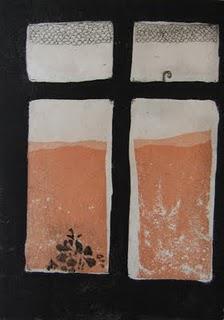 Emma Bradford, Window at Wood CottageEtching, c.1979
Emma Bradford, Window at Wood CottageEtching, c.1979Their Wiltshire home was Wood Cottage, Pigstrough Lane, Donhead St Andrew. I can give you a glimpse of it as it was in 1979, in an etching by my wife, Emma Bradford. There is also a very evocative description of what I take to be Wood Cottage (or if, not, one uncannily like it) in Jane Gardam's novel The Man in the Wooden Hat.

